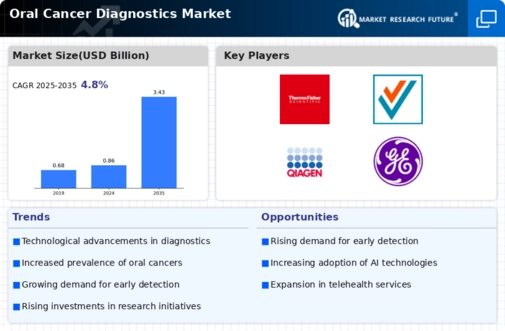Market Analysis
In-depth Analysis of Oral Cancer Diagnostics Market Industry Landscape
The global market for oral cancer diagnostics is poised for significant growth, driven by the increasing innovation efforts of major players in the field. This trend is expected to have a profound impact on the market's expansion over the assessment period. A notable example of such innovation is the collaboration between GE Healthcare and F. Hoffman La Roche Ltd, announced in January 2018. Together, they are working on developing an integrated digital oncology diagnostics platform, reflecting a commitment to advancing diagnostic capabilities.
Another noteworthy advancement came in September 2015 when PeriRx introduced the SaliMark OSCC Test. This cutting-edge molecular DNA test is designed specifically for oral squamous cell carcinoma, showcasing the industry's dedication to enhancing diagnostic tools for specific conditions.
Furthermore, in March 2015, QIAGEN, a prominent player in the field, made strides in expanding its portfolio of liquid biopsies. This expansion was realized through the acquisition of innovative technology that enables the enrichment and molecular analysis of circulating tumor cells (CTCs) from blood samples. This move represents a strategic effort to refine the analysis of tumor cells circulating in the bloodstream, contributing to more precise diagnostics.
The growing global demand for accurate and sophisticated diagnostic devices and systems serves as a catalyst for key players to push the boundaries of innovation. This emphasis on innovation is expected to propel the oral cancer diagnostics market forward in the coming years. The commitment of major players to developing advanced diagnostic platforms, specialized tests, and cutting-edge technologies underlines a dedication to addressing the evolving needs of healthcare professionals and patients in the field of oral cancer diagnostics.
In conclusion, the landscape of oral cancer diagnostics is undergoing a transformative phase marked by collaborations, product introductions, and technological acquisitions by industry leaders. These strategic initiatives not only showcase the commitment of major players to advancing diagnostic capabilities but also underscore the industry's response to the increasing global demand for precise and effective diagnostic solutions. The trajectory of innovation in the oral cancer diagnostics market is poised to contribute significantly to its growth and evolution in the foreseeable future. As technological advancements continue to reshape the diagnostic landscape, healthcare professionals and patients can anticipate more sophisticated and targeted approaches to oral cancer detection and monitoring.







Leave a Comment